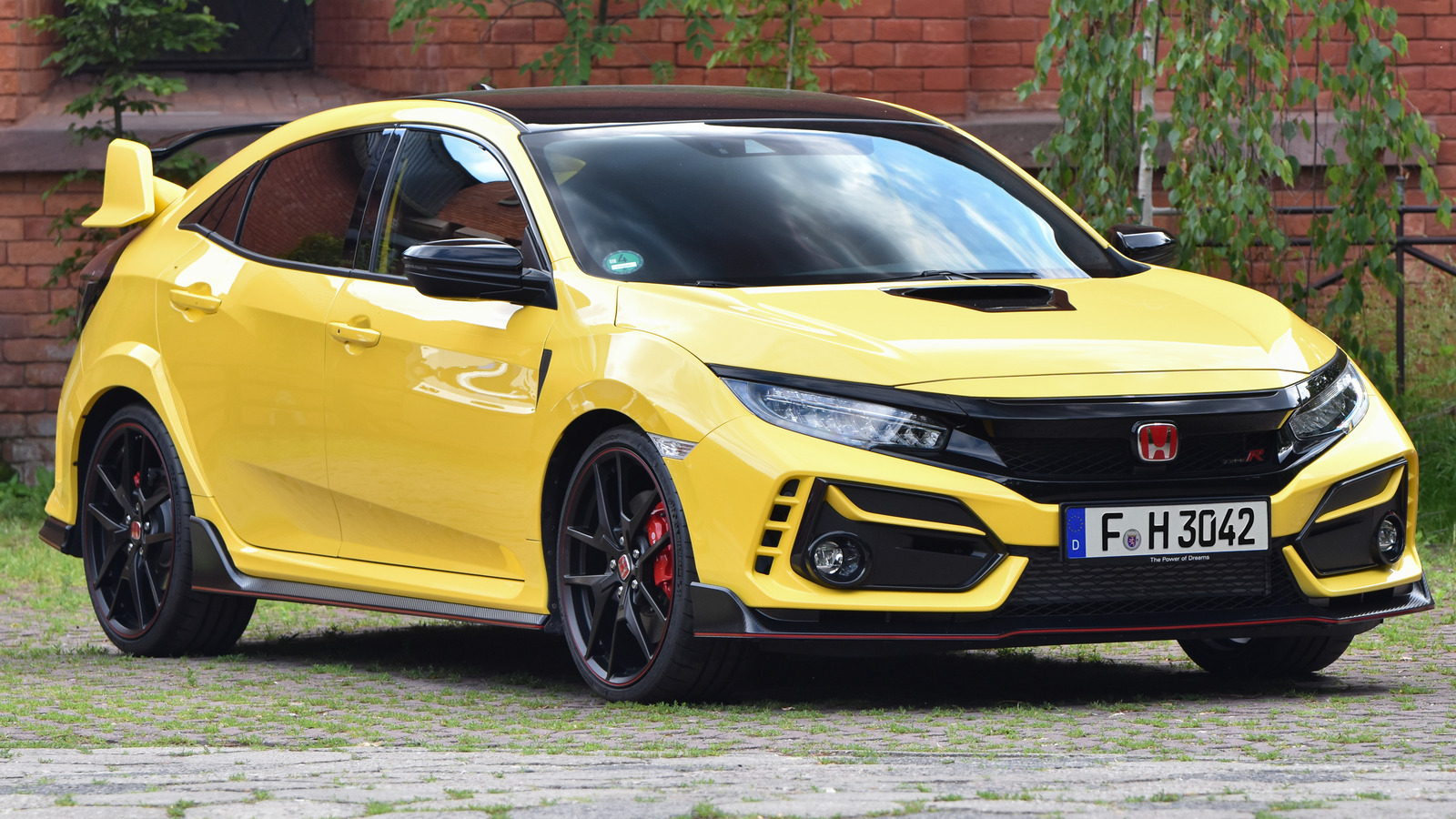It has been over 30 years since the debut of the first Type R vehicle based on Honda’s first supercar, the legendary NSX. Since then, the Japanese manufacturer’s high-performance nameplate has become synonymous with driving enjoyment, courtesy of technology honed by racing. Through the years, we’ve seen Type R versions of the Integra coupe and the Accord sedan, but only the Civic remains available with that moniker.
That’s not surprising, as compact and fast cars have always been Honda’s forte. The company thrived on producing small yet potent engines and always pushed the boundaries in chassis and suspension engineering. As a result, Civic Type R cars are revered in the enthusiast community for their performance, handling, and driving involvement.
Nonetheless, the growth of the Civic Type R hasn’t always been without dips. You’d expect every new iteration to be quicker and faster, but that was not always the case. You can certainly blame emission regulations for some of those performance drops. However, Honda did its fair share of cost cutting by implementing older suspension technology in some of its newer Civic Type Rs.
Here, we will tell you the story of the Civic Type R in terms of speed across each generation from 1997 to present. We will narrate the events through the prism of performance — i.e., acceleration times — but we will, of course, sprinkle them with other interesting facts and figures. So, without further ado, here are all Honda Civic Type R generations ranked from slowest to fastest.
1997-1999 Honda Civic Type R EK9 (0-62 mph in 6.6 seconds, 140 mph)
The first-gen Civic Type R was born quietly — at least from the standpoint of North American and European enthusiasts — as it was a JDM-only affair. North American customers had the choice of a sporty Civic Si, a pretty wild compact coupe with a high-revving 1.6-liter naturally aspirated B16A2 engine producing 160 hp. Still, that was nothing in comparison to the savageness of the JDM Civic Type R, which came with the beloved B16B, one of the best JDM engines for your project car.
This tiny 1.6-liter unit had numbers similar to a racing engine, producing 185 hp at 8,200 rpm and 118 lb-ft of torque at 7,500 rpm, all resulting in a 0-62 time of 6.6 seconds. Honda’s engineers achieved these world-beating numbers by incorporating a new valve system for better engine breathing, higher compression ratio, and reduced friction of the internal components. As you’d expect in a compact car weighing 2,315 pounds, it was a riot, especially once the VTEC kicked in over 6,000 rpm.
The Civic Type R EK9 was not only a one-trick pony, though. Notably, it featured a slick-shifting five-speed manual, which remains a joy to use to this day. Moreover, it had other improvements over the JDM Civic SiR on which it was based, like reduced weight, seam-welded chassis for higher body rigidity, torque-sensitive helical LSD, special high-performance ABS system, and ultra-high-performance Bridgestone Potenza RE010 tires. As a result, the EK9 Type R was an exhilarating drive with sharp handling, a responsive and angry-sounding engine, and outstanding lateral grip. Subsequent Civic Type Rs definitely had a lot to live up to!
2007-2011 Honda Civic Type R Hatchback FN2 (0-62 mph in 6.6 seconds, 146 mph)
For the second-slowest Civic Type R on this list, we actually jump one generation and land on the hot-hatch Civic Type R FN2 offered in Europe. On the outside, this generation Civic hatchback looked as futuristic as it gets, with a design almost completely borrowed from the Civic Concept shown at the 2005 Geneva Motor Show. These concept-car looks, accompanied by the sci-fi interior, wowed customers across Europe.
Naturally, enthusiasts expected a lot from the Type R variant. Sadly, apart from the aggressive, pointy design, the 2007 Civic Type R FN2 was a downgrade in almost every area compared to its predecessor. Up front, it packed the same 2.0-liter naturally-aspirated engine producing 198 hp at 7,800 rpm and 142 lb-ft of torque at 5,600 rpm, exactly like its forebearer. It was almost 70 pounds heavier, too, resulting in worse acceleration to 62 mph.
Emission regulations definitely played a part in the performance downgrade, but Honda did its part in crippling the FN2 in other areas. Nobody would’ve cared about the slightly longer 0-62 mph — 6.6 seconds — times if the FN2 Type R didn’t replace the independent rear suspension of the previous model with a torsion beam, resulting in worse handling overall. Worse yet, Honda tried to mask the handling deficiencies with stiffer springs, which led to a bumpier ride. The FN2 remains a good car to drive in isolation, sporting a high-revving naturally-aspirated engine and 6-speed manual, but it’s definitely not one of Type R’s brightest moments.
2007-2011 Honda Civic Type R Sedan FD2 (0-62 mph in 6.3 seconds, 149 mph)
The third-gen Civic Type R was also available as a sedan in Japan. Unlike its hot-hatch counterpart from Europe, though, the JDM version received the performance upgrades it deserved. To begin with, the FD2 Type R used a slightly altered platform with a longer 106.3-inch wheelbase. Honda said it chose this particular platform for the third-gen JDM Civic Type R for better high-speed stability, but that’s not the only advantage the sedan had over the hatchback.
For instance, the sedan was lighter despite sporting larger overall dimensions, tipping the scales under 2,800 pounds. To achieve this, Honda’s engineers used bonded aluminum in the body shell, which also increased the body rigidity. As a result, the Type R sedan was 50% stiffer than the Integra DC5. The FD2 Type R also had a limited-slip differential for better traction and handling, but crucially, instead of the torsion beam on the hatchback, it had a multi-link rear suspension setup.
All these upgrades make the Civic Type R Sedan a much more enticing proposition than the sci-fi hatchback variant destined for Europe. We still haven’t mentioned FD2’s pièce de resistance feature — the most powerful naturally-aspirated engine ever in a Civic Type R. For this variant, the 2.0-liter unit produced 222 hp at 8,400 rpm and 159 lb-ft at 6,100 rpm, paired to a close-ratio six-speed manual for a much quicker 0-62 mph time of 6.3 seconds. The fact that it’s one of the most reliable high-performance JDM engines is the icing on the cake.
2001-2005 Honda Civic Type R EP3 (0-62 mph in 6.2 seconds, 146 mph)
The second-gen Civic Type R was the first model to be sold out of Japan, much to the delight of enthusiasts in Europe. Although it featured a much larger 2.0-liter naturally-aspirated engine than the first-gen model, producing 212 hp in the JDM variant, which gave it a 0-62 time of 6.2, and 198 hp in Europe. Its launch wasn’t without scrutiny, though. In an effort to make the Civic more practical, Honda opted for a minivan-like body with a shorter hood and longer windscreen, accompanied by a 2.55-inch higher roof compared to the EK9. The move paid its dividends inside, but it took away from the svelte looks of the original.
Still, that’s not to say the EP3 Type R wasn’t a good hot hatch. The JDM model, in particular, was much better equipped than the European one, featuring most of the race-derived upgrades from the original. These include a helical limited-slip differential, stiffer chassis with larger anti-roll bars, and the highest tune of the K20A engine at that time with more aggressive cams and other improvements. Inside, the six-speed shifter was situated high up the dashboard, which looked a bit strange but was easier to reach.
With the improved acceleration times over the predecessor and agile handling, the second-gen Civic Type R remained an excellent driver’s car. It might not have been as extreme, but thanks to the larger engine, it was more usable as a daily driver, which holds true for both the European and JDM models.
2017-2021 Honda Civic Type R FK8 (0-62 mph in 5.8 seconds, 169 mph)
After proving that a turbocharged engine could work in a Civic Type R with the FK2 generation, Honda perfected the formula with the brand-new FK8 model, which was now also available in North America. The automaker continued to use the same 2.0-liter turbocharged four-cylinder engine, though bumped up slightly to 320 hp at 6,500 rpm and producing 295 lb-ft of torque at 4,500 rpm for the Japanese and European markets.
Acceleration times and top speed between the two are similar, with the FK8 reaching 62 mph in 5.8 seconds. However, the FK8 was much better elsewhere, mainly because Honda finally returned to a multi-link independent rear suspension. That, combined with the Adaptive Damper System and a helical limited-slip differential on the front-driven wheels, provides the FK8 Civic Type R with the ideal balance of power and handling. The facelifted 2020 model also has faster active dampers for increased control and more precise steering. While the eccentric styling might not be to everyone’s taste, the FK8 was undoubtedly the best fast hatchback of its era.
Still, the competition didn’t stand still, with most hyper-hatches going AWD for increased traction and drivability. The last Ford Focus RS, for instance, had a 350 hp engine and a trick AWD system with torque vectoring. Despite using only the front wheels to deliver power to the ground, the Civic Type R was competitive with its AWD rivals in terms of performance, which is a testament to Honda’s hot hatch prowess.
2015-2017 Honda Civic Type R FK2 (0-62 mph in 5.7 seconds, 168 mph)
The FK2 Civic Type R marks the biggest shift for the nameplate in its history, as it’s the first one to feature a turbocharged engine. Honda simply couldn’t compete with its naturally-aspirated VTEC engines anymore, especially after Ford launched the Focus RS Mk2 hyper hatch in 2008, which had a massive 2.5-liter turbocharged inline-five producing 305 hp and 325 lb-ft of torque, all routed to the front wheels.
Honda took its time to respond to the new shift in the hot hatch world, finally launching the first turbocharged Civic Type R in 2015. VTEC enthusiasts weren’t exactly pleased with the change in pace, but nobody could argue the performance bump, with the new engine producing a whopping 310 hp at 6,500 rpm and massive 295 lb-ft of torque available anywhere from 2,500 to 4,500 rpm, all of which resulted in 0-62 time of 5.7 seconds. Although the turbocharger was behind the power hike, Honda kept its VTEC valvetrain to let the engine breathe even better. As a result, the new 2.0-liter turbo-four had a 7,000-rpm redline — pretty high for this type of engine.
As always, though, the Civic Type R wasn’t only about the engine — Honda approached the hyper hatch formula holistically. This meant that the outlandish-looking FK2 Type R still had the best six-speed manual in the business, along with a helical limited-slip differential for better utilization of the front wheels. Unfortunately, the FK2 retained the torsion beam rear axle, but Honda engineers were able to make it work this time around.
2022-Present Honda Civic Type R FL5 (0-62 mph in 5.4 seconds, 170 mph)
The latest Civic Type R continued with the same formula as the two predecessors — turbocharged engine, front-wheel drive, and six-speed manual. Still, Honda gave it a slight power bump. In Japan and Europe, it now produces 329 hp and 310 lb-ft of torque — which gave it a 0-62 time of 5.4 seconds — while the North American version getting a 315 hp tune.
As a result, the FL5 Civic Type R is the quickest and the fastest of all generations. However, it’s not as quick as most modern sports cars off the line, simply because there is not enough traction from the front wheels. However, in an era of hyper-quick EVs that catapult you off the line, straight-line performance often takes the second stage.
Once you get going, the FL5 Civic Type R is plenty fast, but crucially, it has an exceptionally rewarding engine, gearbox, and suspension combination that few, if any, cars can beat. It’s again that holistic approach that differentiates the Civic Type R from its hot-hatch rivals. The GR Corolla, for example, has a massive cornering grip thanks to its rally-derived AWD system, but still can’t match the Type R’s precision through the corners.
It certainly helps that the FL5 Civic Type R is a highly usable daily driver with a spacious, well-equipped cabin. Honda also finally broke up with its anime-derived styling — the FL5 looks more grown up but still delivers the necessary hyper-hatch drama front with triple exhaust pipes and a huge wing in the back.



